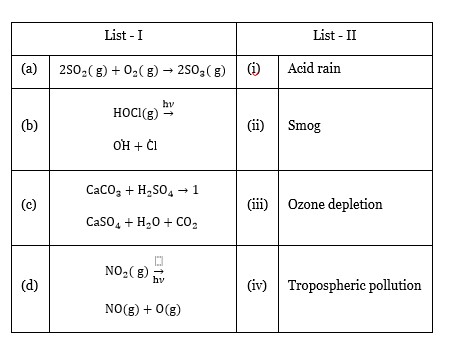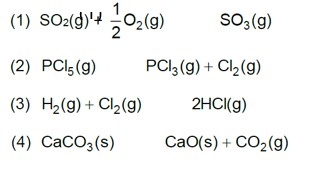Match List - I with List - II
Choose the correct answer from the options given below.
Match List - I with List - II
Choose the correct answer from the options given below.
Option 1 -
(a) - (i), (b) - (ii), (c)-(iii), (d) - (iv)
Option 2 -
(a) - (ii), (b) - (iii), (c)-(iv), (d) - (i)
Option 3 -
(a) - (iv), (b) - (iii), (c)-(i), (d) - (ii)
Option 4 -
(a) - (iii), (b) - (ii), (c)-(iv), (d) - (i)
-
1 Answer
-
Correct Option - 3
Detailed Solution:| List-I | | List-II |
| :- | :- | :- |
| (a) 2SO? (g) + O? (g) → 2SO? (g) | (iv) | Tropospheric pollution |
| (b) HOCl (g) - (hν)->? H +? l | (iii) | Ozone depletion |
| (c) CaCO? + H? SO? → | (i) CaSO? + H? O + CO? | Acid rain |
| (d) NO? (g) - (hν)-> NO (g) + O (g) | (ii) | Smog |
Similar Questions for you
0.01 M NaOH,
M = 1 * 10-2

pOH = 2
pH = 2
Kp = Kc (RT)Dng
36 * 10–2 = Kc (0.0821 * 300)–1
Kc = 0.36 * 0.0821 * 300 = 8.86 » 9
A(g) ->B(g) + (g)
Initial moles n 0 0
Eqb. moles n(1 – a) na
total moles =
Eqb. pressure
On increasing pressure, equilibrium moves in that direction where number of gaseous moles decreases.
Taking an Exam? Selecting a College?
Get authentic answers from experts, students and alumni that you won't find anywhere else
Sign Up on ShikshaOn Shiksha, get access to
- 65k Colleges
- 1.2k Exams
- 681k Reviews
- 1800k Answers



